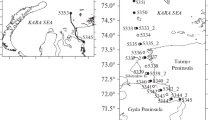Abstract
This paper presents results of long-term (2008 and 2012–2019) studies of phytoplankton and phytobenthos in seven highly mineralized rivers of the Lake Elton basin. Two-hundred-and-fourteen algal taxa belonging to seven systematic divisions have been identified in the algal flora; of them, the division Bacillariophyta features the greatest species richness and abundance. A comparative analysis of the taxonomic structure and species diversity of algocoenoses in the mineralization gradient was performed. The following structure-forming species represented by widespread euryhaline taxa were identified: Chaetoceros muelleri Lemm., Conticribra weissflogii (Grun.) S. Suchoples et Williams, Nitzschia closterium Ehr., Halamphora coffeaeformis (Ag.) Meresch., and Achnanthes brevipes Ag., (Bacillariophyta), as well as Cyanoprokaryota (Phormidium breve (Kütz. ex Gom.) Anagn. & Kom., Oscillatoria limosa Ag. ex Gom., O. tenuis Ag. ex Gom., and Geitlerinema amphibium (Ag. ex Gom.) Anagn.). Species of the genus Dunaliella (Chlorophyta) predominate in rivers featuring critical salinity conditions. It is established that the abundance and biomass of algae in algocoenoses vary in a wide range and do not depend on the mineralization level. In mesohaline rivers, the negative correlation between specific species richness and mineralization is weak; while in polyhaline rivers, it is statistically significant (R = –0.50, R = –0.52, p < 0.05). Seasonal dynamics of planktonic algocoenoses is manifested by changes in the species structure, abundance, and biomass.





Similar content being viewed by others
REFERENCES
Alimov, A.F., Biological diversity and the community structure of organisms, Inland Water Biol., 2012, vol. 3, no. 3, p. 207–213.
Clavero, E., Hernández-Mariné, M., Grimalt, J.O., and Garcia-Pichel, F., Salinity tolerance of diatoms from thalassic hypersaline environments, Phycology, 2000, vol. 36, no. 6, pp. 1021–1034.
Fedorov, V.D., O metodakh izucheniya fitoplanktona i ego aktivnosti (About Methods of Studying Phytoplankton and Its Activity), Moscow: Mosk. Gos. Univ., 1979.
Genkal, S.I. and Gorokhova, O.G., Diatoms (Bacillariophyta) of rivers flowing into Lake Elton, Botanicheskii Zhurnal, 2021, vol. 106, no. 4.
Genkal, S.I. and Gorokhova, O.G., New data on morphology of some widespread and rare pennate diatoms (Bacillariophyta), Novosti Sistematiki Nizshikh Rastenii, 2022, vol. 56, no. 1, pp. 9–18.
Genkal, S.I., Gorokhova, O.G., and Gololobova, M.A., New data on the morphology of Achnanthes brevipes (Bacillariophyta), Novosti Sistematiki Nizshikh Rastenii, 2021, vol. 55, no. 2, pp. 307–314.
Gorokhova, O.G. and Zinchenko, T.D., Phytoplankton of highly mineralized rivers of the Elton region, Izvestiya Samarskogo Nauchnogo Tsentra Ros. Akad. Nauk, 2014, vol. 16, no. 5 (5), pp. 1715–1721.
Gorokhova, O.G. and Zinchenko, T.D., The diversity and community structure of phytoplankton of highly mineralized rivers of Elton lake basin, Voda: Khimiya i Ekologiya, 2016, no. 11, pp. 58–65.
Gorokhova, O.G. and Zinchenko, T.D., Communities of Benthic Algae of Salt Rivers in the Basin of Lake Elton: Taxonomic and Quantitative Structure, Biology Bulletin, 2021, vol. 48, no. 10, pp. 138–146.
Kanapatskii, T.A., Samylina, O.S., and Kuznetsova, A.I., Primary production of phototrophic communities of brackish rivers in the Elton region (Volgograd region), Doklady Bashkirskogo Universiteta, 2018, vol. 3, no. 4, pp. 416–421.
Karlson, B., Cusak, C., and Bresnan, E., Microscopic and Molecular Methods for Quantitative Phytoplankton Analysis. IOC Manuals and Guides No. 55, Paris, UNESCO, 2010.
Lazareva, V.I., Gusakov, V.A., Zinchenko, T.D., and Golovatyuk, L.V., Zooplankton of saline rivers in the arid zone of southern Russia (Lake Elton basin), Zoologicheskii Zhurnal, 2013, vol. 92, no. 8, pp. 882–892.
Metodika izucheniya biogeotsenozov vnutrennikh vodoemov (Methodology for studying biogeocenoses of inland water bodies), Moscow: Nauka, 1975.
Prieto-Barajas, C.M., Valencia-Cantero, E., and Santoyo, G., 2018. Microbial mat ecosystems: Structure types, functional diversity, and biotechnological application, Electronic Journal of Biotechnology, vol. 31, pp. 48–56.
Safonova, T.A. and Ermolaev, V.I., Vodorosli vodoemov sistemy ozera Chany (Algae of water bodies of the Chany Lake system.), Novosibirsk, 1983.
Taukulis, F.E. and John, J., Diatom communities in lakes and streams of varying salinity from south-west western australia: distribution and predictability, Journal of the Royal Society of Western Australia, 2006, vol. 89, pp. 17–25.
Underwood, G. and Provot, L., Determining the environmental preferences of four estuarine epipelic diatom taxa: growth across a range of salinity, nitrate and ammonium conditions, European Journal of Phycology, vol. 35, no. 2, pp. 173–182.
Vodorosli. Spravochnik (Algae. Guidebook), Vasser, S.P, Kondrat’ev, N.V, and Masyuk, N.P, Eds., Kyiv: Naukova Dumka, 1989.
Yatsenko-Stepanova, T.N., Ignatenko, M.E., Nemtseva, N.V., and Gorokhova, O.G., Autotrophic Microorganisms in River Outfalls of Lake Elton, Arid Ecosyst., 2015, vol. 5, no. 2, pp. 83–87.
Zinchenko, T.D., Golovatyuk, L.V., Gorokhova, O.G., Abrosimova, E.V., Umanskaya, M.V., Popchenko, T.V., Shitikov, V.K., Gusakov, V.I., Bolotov, S.E., Lazareva, V.I., Selivanova, E.A., Balkin, A.S., and Plotnikov, A.O., Functional features of the structural organization of plankton and bottom communities of highly mineralized rivers of the hypersaline Lake Elton basin (Russia), Ekosistemy: Ekologiya i Dinamika, 2021, vol. 5, no. 1, pp. 5–73.
Funding
This study was supported by the Russian Foundation for Basic Research, project no. 17-04-00135 and performed as part of the State Assignment, project no. AAAA-A17-117112040040-3 (Assessment of the Current Biodiversity and Forecast of Its Changes in Ecosystems of the Volga River Basin amid Their Natural and Anthropogenic Transformation).
Author information
Authors and Affiliations
Corresponding authors
Ethics declarations
Conflict of interest. The authors declare that they have no conflict of interest.
Additional information
Translated by L. Emeliyanov
Rights and permissions
About this article
Cite this article
Gorokhova, O.G., Zinchenko, T.D. Planktonic and Benthic Algocoenoses in Highly Mineralized Rivers that Drain into Lake Elton. Arid Ecosyst 12, 516–524 (2022). https://doi.org/10.1134/S2079096122040059
Received:
Revised:
Accepted:
Published:
Issue Date:
DOI: https://doi.org/10.1134/S2079096122040059




